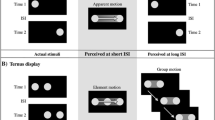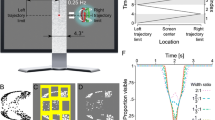Abstract
The detailed dynamics of action simulation was investigated using the occluder paradigm: a point light actor (PLA) was shown, then briefly occluded from view, during which period action simulation was generated. Following occlusion, the PLA reappeared, either a progression of the motion as it should be post-occlusion or temporally shifted earlier/later. Participants made judgements on whether the reappearing PLA was too early or too late to be a correct continuation (Experiments 1 and 3) or whether it was a veridical continuation or not (Experiment 2). Over three experiments we asked how action simulation is affected by motion information before, during and after occlusion. Reducing motion presented before occlusion retained the accuracy of action simulation judgements. Presenting 4 frames (67 ms) of PLA motion during the occluder duration dynamically updates or altogether regenerates the action simulation. Reducing the duration of the test motion after the occluder decreases judgement precision, which we interpret as a limitation in the process of postdictive motion judgments. Overall, this is further evidence that the action simulation process is remarkably adapted to making human motion predictions.






Similar content being viewed by others
Notes
Repeated measures t test between mean slope values for 1,000 and 500 ms.
The spatial position of the early/late inserted motions was made equivalent within the occluder box to that of the congruent inserted motions by moving the initial position of the pelvis point of the former to that of the latter. Thus, gross spatial incongruency of where the PLA was on screen when he briefly appeared within the occluder was not an issue.
Here, this is inferred using psychophysical curve-fitting to “early” and “late” judgements.
References
Bertenthal, B. I., Longo, M. R., & Kenny, S. (2007). Phenomenal permanence and the development of predictive tracking in infancy. Child Development, 78(1), 350–363.
Brainard, D. H. (1996). The psychophysics toolbox. Spatial Vision, 10(4), 433–436.
Flanagan, J. R., & Johansson, R. S. (2003). Action plans used in action observation. Nature, 424(6950), 769–771.
Gibson, J. J., Kaplan, G., Reynold, H. N., & Wheeler, K. (1969). The change from visible to invisible: A study of optical transitions. Perception & Psychophysics, 5, 113–116.
Giese, M. A., & Poggio, T. (2003). Neural mechanisms for the recognition of biological movements. Nature Reviews Neuroscience, 4(3), 179–192.
Graf, M., Reitzner, B., Corves, C., Casile, A., Giese, M., & Prinz, W. (2007). Predicting pointlight actions in real-time. NeuroImage, 36, T22–T32.
Johansson, G. (1972). Visual perception of biological motion and a model for its analysis. Perception & Psychophysics, 14(2), 201–211.
Johansson, G. (1976). Spatio-temporal differentiation and integration in visual motion perception. An experimental and theoretical analysis of calculus-like functions in visual data processing. Psychological Research, 38(4), 379–393.
Kilner, J. M., Friston, K. J., & Frith, C. D. (2007). Predictive coding: an account of the mirror neuron system. Cognitive Processing, 8(3), 159–166.
Kleiner, M., Brainard, D., & Pelli, D. (2007). What’s new in Psychtoolbox-3. Perception, 36, 14.
Oldfield, R. C. (1971). The assessment and analysis of handedness: The Edinburgh inventory. Neuropsychologia, 9(1), 97–113.
Oram, M. W., & Perrett, D. I. (1996). Integration of form and motion in the anterior superior temporal polysensory area (STPa) of the macaque monkey. Journal of Neurophysiology, 76(1), 109–129.
Parkinson, J., Springer, A., & Prinz, W. (2011). Can you see me in the snow? Action simulation aids the detection of visually degraded human motion. Quarterly Journal of Experimental Psychology, 64(8), 1463–1472.
Pelli, D. G. (1996). The VideoToolbox software for visual psychophysics: Transforming numbers into movies. Spatial Vision, 10(4), 437–442.
Scholl, B. J., & Pylyshyn, Z. W. (1999). Tracking multiple items through occlusion: Clues to visual objecthood. Cognitive Psychology, 38(2), 259–290.
Sparenberg, P., Springer, A., & Prinz, W. (2012). Predicting others’ actions: Evidence for a constant time delay in action simulation. Psychological Research, 76(1), 41–49.
Springer, A., Brandstädter, S., Liepelt, R., Birngruber, T., Giese, M., Mechsner, F., et al. (2011). Motor execution affects action prediction. Brain and Cognition, 76, 26–36.
Springer, A., & Prinz, W. (2010). Action semantics modulate action prediction. Quarterly Journal of Experimental Psychology, 63(11), 2141–2158.
Stadler, W., Schubotz, R. I., von Cramon, D. Y., Springer, A., Graf, M., & Prinz, W. (2011). Predicting and memorizing observed action: differential premotor cortex involvement. Human Brain Mapping, 32(5), 677–687.
Thirkettle, M., Benton, C. P., & Scott-Samuel, N. E. (2008). Contributions of form, motion and task to biological motion perception. Journal of Vision, 9(3), 28.
Wichmann, F., & Hill, N. (2001). The psychometric function: I. Fitting, sampling, and goodness of fit. Perception & Psychophysics, 63(8), 1293–1313.
Wilson, M., & Knoblich, G. (2005). The case for motor involvement in perceiving conspecifics. Psychological Bulletin, 131(3), 460–473.
Wolpert, D. M. (1997). Computational approaches to motor control. Trends in Cognitive Sciences, 1(6), 209–216.
Wolpert, D. M., Ghahramani, Z., & Jordan, M. I. (1995). An internal model for sensorimotor integration. Science, 269(5232), 1880–1882.
Author information
Authors and Affiliations
Corresponding author
Rights and permissions
About this article
Cite this article
Parkinson, J., Springer, A. & Prinz, W. Before, during and after you disappear: aspects of timing and dynamic updating of the real-time action simulation of human motions. Psychological Research 76, 421–433 (2012). https://doi.org/10.1007/s00426-012-0422-3
Received:
Accepted:
Published:
Issue Date:
DOI: https://doi.org/10.1007/s00426-012-0422-3




